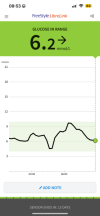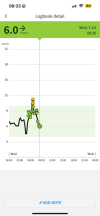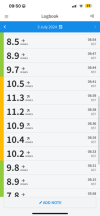Hi, applied my Libre 2 sensor for the first time last night before bed, I’ve read about dawn phenomenon and have done some finger prick readings while waking/ mid morning but never with this level of constant monitoring. Is this typical dawn phenomenon. It’s 08:55 and I seem to be sitting at constantly around 6 and have done for the past 45 mins ish.
Is there a way to stop this without medication or is it normal? My log book shows it more quickly if you can see over the dots. I’ve gone too excited with scanning, ha.

Is there a way to stop this without medication or is it normal? My log book shows it more quickly if you can see over the dots. I’ve gone too excited with scanning, ha.



